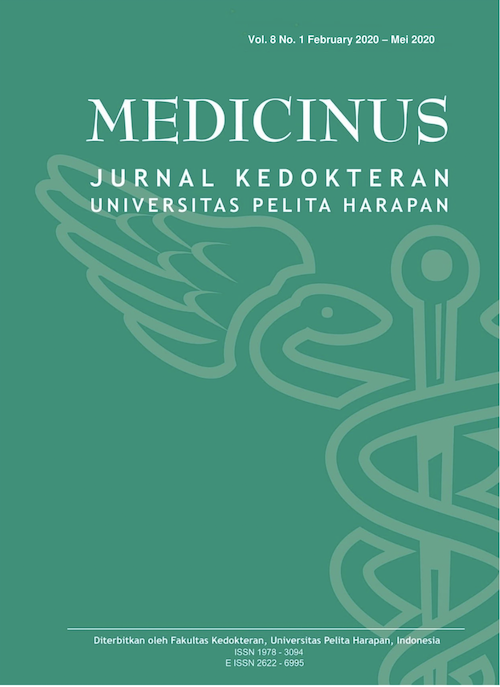Relationship of Flat Foot and Plantar Fascia Thickness in Medical Students of Pelita Harapan University
DOI:
https://doi.org/10.19166/med.v8i1.3119Keywords:
flat foot, plantar fascia thickness, medical studentsAbstract
Background : Plantar fascia plays significant role in supporting the height and structure of Medial Longitudinal Arch (MLA). In flat foot, the MLA is depressed. There is thickening of plantar fascia reported in cases of plantar fasciitis in subjects with flat foot. Therefore, research needs to be done to investigate the relation between flat foot and plantar fascia thickness.
Aim: To understand the relationship between flat foot and plantar fascia thickness among medical students of Pelita Harapan University.
Methods : This study was conducted using cross-sectional method with sampling method of non-random consecutive sampling. Data was collected through examinations performed and adjustments are made using inclusion and exclusion criteria. Flat foot was determined using navicular drop test and plantar fascia thickness was assessed using ultrasonography measurement. Results were analyzed using SPSS 22.0 and statistically tested using Spearman’s rho test.
Result : The analysis of the relationship between flat foot and plantar fascia thickness showed positive correlation with correlation coefficient of 0.634 on the right foot and 0.443 on the left.
Conclusion : There is moderate and strong positive relationship between flat foot and plantar fascia thickness among medical students of Pelita Harapan University.
References
1. Anderson RB, Davis WH. Management of the adult flatfoot deformity. In: Myerson MS. Foot and Ankle Disorders. 1st ed. Philadelphia: WB Saunders, 2000: 1017-25.
2. Kosashvili Y, et al. The correlation between pes planus and anterior knee or intermittent low back pain. Foot Ankle Int 2008;29(9):910-3.
https://doi.org/10.3113/FAI.2008.0910
3. Haendlmayer K, Harris N. Flatfoot deformity: an overview. J Orthop Trauma 2009;23(6):395-403. https://doi.org/10.1016/j.mporth.2009.09.006
4. Kido M, Ikoma K, Imai K, Tokunaga D, Inoue N, Kubo T. Load response of the tarsal bones in patients with flatfoot deformity: in vivo 3D study. Foot Ankle Int 2011;32(11):1017-22.
https://doi.org/10.3113/FAI.2011.1017
5. Wearing SC, Smeathers JE, Yates B, Urry SR, Dubois P. Plantar Fascitiis: Are Pain and Fascial Thickness Associated with Arch Shape and Loading? Phys Ther. 2007;87(8).
https://doi.org/10.2522/ptj.20060136
6. Erdemir A, Hamel AJ, Fauth AR, Piazza SJ, Sharkey NA. Dynamic loading of the plantar aponeurosis in walking. J Bone Joint Surg Am 2004; 86-A:546-552.
https://doi.org/10.2106/00004623-200403000-00013
7. Neumann DA. Kinesiology of the musculoskeletal system: foundations for rehabilitation. 3rd ed. St. Louis (MO): Mosby; 2016.
8. Tsai WC, Wang CL, Tang FT, et al: Treatment of proximal plantar fasciitis with ultrasound-guided steroid injection. Arch Phys Med Rehabil 81: 1416, 2000.
https://doi.org/10.1053/apmr.2000.9175
9. Schepsis AA, Leach RE, Gorzyca J. Plantar fasciitis: etiology, treatment, surgical results, and review of the literature. Clin Orthop Rel Res 1991; 256:185-96.
https://doi.org/10.1097/00003086-199105000-00029
10. Huang YC, Wang LY, Wang HC, Chang KL, Leong C-P. The Relationship between the Flexible Flatfoot and Plantar Fasciitis: Ultrasonographic Evaluation. Chang Gung Med J. 2004;27:443-8.
11. Singh D, Angel J, Bentley G, Trevino SG. Fortnightly review: Plantar fasciitis. BMJ 1997; 315: 172-5.
https://doi.org/10.1136/bmj.315.7101.172
12. Karabay N, Toros T, Hurel C: Ultrasonographic evaluation in plantar fasciitis. J Foot Ankle Surg 46: 442, 2007.
https://doi.org/10.1053/j.jfas.2007.08.006
13. McMillan AM, Landorf KB, Barrett JT, et al: Diagnostic imaging for chronic plantar heel pain: a systematic review and meta-analysis. J Foot Ankle Res 2: 32, 2009.
https://doi.org/10.1186/1757-1146-2-32
14. Wearing SC, Smeathers JE, Urry SR, et al: The pathomechanics of plantar fasciitis. Sports Med 36: 585, 2006.
https://doi.org/10.2165/00007256-200636070-00004
15. Rajakaruna RMBD, Arulsing W, Raj JO, Sinha M. A Study To Correlate Clinically Validated Normalized Truncated Navicular Height To Brody’s Navicular Drop Test in Characterizing Medial Arch of the Foot. BMR Med. 2015;2(1):1-7.
16. Loudon, J. K., Jenkins, W., & Loudon, K. L. (1996). The relationship between static posture and ACL injury in female athletes. J Orthop Sports Phys Ther, 24(2), 91- 97. doi: 10.2519/jospt.1996.24.2.91.
https://doi.org/10.2519/jospt.1996.24.2.91
17. Hastono S. Analisis Data Pada Bidang Kesehatan. Jakarta: Rajawali Pers; 2016.
18. Cardinal E, Chhem RK, Beauregard CG, et al: Plantar fasciitis: sonographic evaluation. Radiology 201: 257, 1996.
https://doi.org/10.1148/radiology.201.1.8816554
19. Karabay N, Toros T, Hurel C: Ultrasonographic evaluation in plantar fasciitis. J Foot Ankle Surg 46: 442, 2007.
https://doi.org/10.1053/j.jfas.2007.08.006
20. Mcmillan AM, Landorf KB, Barrett JT, et al: Diagnostic imaging for chronic plantar heel pain: a systematic review and metaanalysis. J Foot Ankle Res 2: 32, 2009.
https://doi.org/10.1186/1757-1146-2-32
21. TaÅŸ S. Effect of Gender on Mechanical Properties of the Plantar Fascia and Heel Fat Pad. Foot Ankle Spec [Internet]. 2017;XX(X):193864001773589.
https://doi.org/10.1177/1938640017735891
22. Abul K, Ozer D, Sakizlioglu SS, Buyuk AF, Kaygusuz MA. Detection of Normal Plantar Fascia Thickness in Adults via the Ultrasonographic Method. J Am Podiatr Med Assoc. 2015;105(1):8-13.
https://doi.org/10.7547/8750-7315-105.1.8
23. TaÅŸ S, Bek N, Ruhi Onur M, Korkusuz F. Effects of Body Mass Index on Mechanical Properties of the Plantar Fascia and Heel Pad in Asymptomatic Participants. Foot Ankle Int. 2017;38(7):779-84.
https://doi.org/10.1177/1071100717702463
24. Uzel M, Cetinus E, Ekerbicer HC, Karaoguz A. The influence of athletic activity on the plantar fascia in healthy young adults. J Clin Ultrasound. 2005;34(1):17-21.
https://doi.org/10.1002/jcu.20178
25. World Health Organisation. The Asia-Pacific perspective: redefining obesity and its treatment. Geneva, Switzerland: World Health Organization. 2000.
Downloads
Published
How to Cite
Issue
Section
License
Copyright (c) 2021 Livia Taniwangsa, Yusak M.T. Siahaan

This work is licensed under a Creative Commons Attribution-ShareAlike 4.0 International License.
Authors who publish with this journal agree to the following terms:
1) Authors retain copyright and grant the journal right of first publication with the work simultaneously licensed under a Creative Commons Attribution License (CC-BY-SA 4.0) that allows others to share the work with an acknowledgement of the work's authorship and initial publication in this journal.
2) Authors are able to enter into separate, additional contractual arrangements for the non-exclusive distribution of the journal's published version of the work (e.g., post it to an institutional repository or publish it in a book), with an acknowledgement of its initial publication in this journal.
3) Authors are permitted and encouraged to post their work online (e.g., in institutional repositories or on their website). The final published PDF should be used and bibliographic details that credit the publication in this journal should be included.





